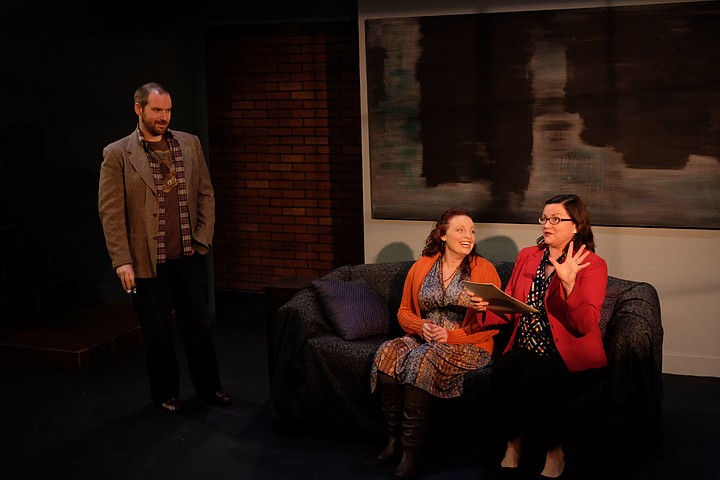 Facebook
Facebook
 X
X
 Instagram
Instagram
 TikTok
TikTok
 Youtube
Youtube

Tom Donaghy’s comedy-drama asks: can people change? And will that change be for the better?
Boys and Girls (2002) puts a relatively new social phenomenon on stage: same-sex couples having children. In the process differences blend, and often give way, to similarities and important questions about parenthood in general.
Reed and Jason were lovers. They meet, after a messy breakup, and ponder getting back together. But the boundary-free Jason still drinks to excess and abhors notions of therapy. Can Jason change? Can he grow up?
Can Reed and Bev? After years of wild-childing, they tired of running red lights and opted for adulthood. Bev found a partner in Shelly. To outsiders, lockstep Shelly may seem severe — she loves to give orders — but to Bev she’s stability, both emotional and financial, and a co-parent for Bev’s young son.

When the women want a father, even if only part-time, Reed’s the obvious choice. But Jason may come with him. And though they say that opposites can attract, Jason and Shelley are a severe exception to that rule.
The play has dramatic possibilities. The script, however, is more concerned with the themes than viable characters. It has lulls and sudden, soap operatic leaps. The playwright manipulates the quartet, like pawns, for confrontations and contrasts.
Donaghy has been praised for his David Mamet-like dialogue. But what looks like chaos on Mamet’s pages has acres of subtexts underneath. Donaghy’s dialogue has snippets of speech (and a fragile anxiety equal to Mamet), but subtexts are few. The characters exist to illustrate variations on a theme. How they grow and change plays third fiddle.
I wish the script were up to the efforts Diversionary Theatre has given it. Matt Scott’s set is one of the company’s most appealing in years. Soft greens, just the right amount of furniture, and a stairway – believable, even under a low ceiling — up to a second floor.
The design’s as functional as inventive. Luke Olson’s excellent lighting shapes the stage into discrete locales. And a hallmark touch: when actors exit through an upstage door, they freeze in a cone of light. The images button scenes with eloquent stillness.
The actors, under Shana Wride’s sensitive direction, do what they can. Faeren Adams gives Shelly believable emotions, but the character as written is a one-note case study in control issues. Jason, by obvious contrast, is a study in out-of-control issues, though Andrew Oswald hides most of the seams with a fluid performance.
The script gives Reed and Bev more emotional range, and Anthony Methvin and Chrissy Burns make good use of it in scene after scene. In yet another obvious contrast (to Jason, suddenly grown up) Reed shifts from caregiver to needy human being. Methvin does a nice job not only of tracing the downward path but suggesting that Reed just might retrace it once again.


Tom Donaghy’s comedy-drama asks: can people change? And will that change be for the better?
Boys and Girls (2002) puts a relatively new social phenomenon on stage: same-sex couples having children. In the process differences blend, and often give way, to similarities and important questions about parenthood in general.
Reed and Jason were lovers. They meet, after a messy breakup, and ponder getting back together. But the boundary-free Jason still drinks to excess and abhors notions of therapy. Can Jason change? Can he grow up?
Can Reed and Bev? After years of wild-childing, they tired of running red lights and opted for adulthood. Bev found a partner in Shelly. To outsiders, lockstep Shelly may seem severe — she loves to give orders — but to Bev she’s stability, both emotional and financial, and a co-parent for Bev’s young son.

When the women want a father, even if only part-time, Reed’s the obvious choice. But Jason may come with him. And though they say that opposites can attract, Jason and Shelley are a severe exception to that rule.
The play has dramatic possibilities. The script, however, is more concerned with the themes than viable characters. It has lulls and sudden, soap operatic leaps. The playwright manipulates the quartet, like pawns, for confrontations and contrasts.
Donaghy has been praised for his David Mamet-like dialogue. But what looks like chaos on Mamet’s pages has acres of subtexts underneath. Donaghy’s dialogue has snippets of speech (and a fragile anxiety equal to Mamet), but subtexts are few. The characters exist to illustrate variations on a theme. How they grow and change plays third fiddle.
I wish the script were up to the efforts Diversionary Theatre has given it. Matt Scott’s set is one of the company’s most appealing in years. Soft greens, just the right amount of furniture, and a stairway – believable, even under a low ceiling — up to a second floor.
The design’s as functional as inventive. Luke Olson’s excellent lighting shapes the stage into discrete locales. And a hallmark touch: when actors exit through an upstage door, they freeze in a cone of light. The images button scenes with eloquent stillness.
The actors, under Shana Wride’s sensitive direction, do what they can. Faeren Adams gives Shelly believable emotions, but the character as written is a one-note case study in control issues. Jason, by obvious contrast, is a study in out-of-control issues, though Andrew Oswald hides most of the seams with a fluid performance.
The script gives Reed and Bev more emotional range, and Anthony Methvin and Chrissy Burns make good use of it in scene after scene. In yet another obvious contrast (to Jason, suddenly grown up) Reed shifts from caregiver to needy human being. Methvin does a nice job not only of tracing the downward path but suggesting that Reed just might retrace it once again.
Comments